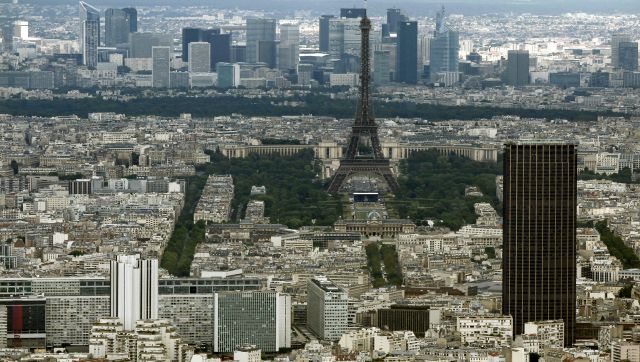Travel to Paris and a look around its skyline and there’s something that will stand out – the Eiffel Tower that stands tall at 330 metres and the Montparnasse Tower, standing at 210 metres (689 feet). While one has become synonymous with the City of Lights, the other, the Montparnasse Tower, shares a weird relationship with the people. Most Parisians consider the 59-storey chocolate-coloured glass tower as out of place. Their disdain for the high-rise isn’t singular. In fact, Paris’ dislike for high-rises is so strong that they have re-imposed a ban on tall buildings in a bid to preserve its low-rise skyline. Through the Plan Local d’Urbanisme’, the city is restricting the height of structures to 12 storeys – or 37 metres. But why have such a ban? What’s the reason Parisians want a low-rise city? Paris’ low-rise skyline To understand Paris’ love for low-rise buildings, we have to look back into the past. Napoleon III sought to turn the city in a symbol of
French grandeur in the mid-19th century. To realise his dream, he appointed Baron Georges-Eugene Haussmann to transform the capital into a vibrant, modern European city. Haussmann razed many of Paris’ cramped medieval streets and decrepit buildings to make way for wide avenues, public squares, parks and a new sewer system, all of which helped to revitalise and clean up the city. He also introduced Haussmannian apartment buildings – six-storey, stone-façade buildings that are visible even today across the city. After World War II ended, there was a need among the people of Paris to redevelop. Many believed that Paris needed to follow in the footsteps of the United States and the United Kingdom with their nationwide highways and new skyscrapers. As Virginie Picon-Lefebvre, a professor of architecture at the Ecole Nationale Superieure d’Architecture Paris-Belleville and expert in the capital’s postwar architectural history, told CNN, “On the ruins of the disaster of war, they wanted to build something completely new for a new generation.” And hence, in 1973, came the Montparnasse Tower. The 231-metre-tall building, designed by architects Eugène Beaudouin, Urbain Cassan, and Louis Hoym de Marien and built by Campenon Bernard, became France’s tallest skyscraper and held on to that badge of honour until 2011. [caption id=“attachment_12748552” align=“alignnone” width=“640”] Montparnasse tower seen dominating the Paris skyline. Standing at 210 metres, it was inaugurated in 1973. File image/Reuters[/caption] But the initial hoopla around the building died and locals criticised it for its looming presence. Many called it out of place where buildings were just six-stories high. And in 1977, the City of Lights turned dark on tall buildings, restricting constructions to 37 metres. That ban was in place until 2010. It was overturned by former Mayor Bertrand Delanoë for a limit of 180 metres for office towers and 50 metres for housing blocks. A new ban on high-rises Last week, even as Paris marked the 50th anniversary of the construction of the Montparnasse Tower, the city council voted in favour of limiting the height of new buildings and adopted a new ‘Plan Local d’Urbanisme’ (PLU). The new ban, instigated by Green Councillor Émile Meunier and brought about by Mayor Anne Hidalgo, is part of a larger Bioclimatic Urban Plan which aims to reduce carbon emissions in the city. It has also come in response to the construction of Herzog & de Meuron‘s Tour Triangle tower. The construction on the 180-metre Tour Triangle began in 2021 and is expected to be completed by 2026. Set to stand at 42 storeys with 91,351 square metres of floor space, the Triangle would become the third-tallest building within the Paris city limits, behind only Tour Montparnasse and the Eiffel Tower. [caption id=“attachment_12748492” align=“alignnone” width=“640”]
 Herzog & de Meuron’s Tour Triangle construction. Planned for Avenue Ernest-Renan, the building will contain offices, a conference centre, shops, restaurants and a hotel. Image Courtesy: Herzog & de Meuron[/caption] Reacting to the ban, Émile Meunier was quoted as saying,” They said Paris was naff and needed high towers to compete with London’s city. Now it’s the end of towers in Paris. The new local urban plan of Paris marks the end of the towers and returns to a reasonable height.” Not just Paris though However, Paris isn’t the only place in the world to impose a ban on high-rise constructions.
China , home to some of the world’s tallest buildings, in 2021 also placed a ban on ‘super skyscrapers’ in smaller cities across the country. According to the rules, skyscrapers taller than 150 metres (490 ft) will be strictly limited, and those higher than 250 metres (820 ft) will be banned for cities with a population of fewer than three million. In cities with over three million people, authorities have limited structures taller than 250 metres. [caption id=“attachment_12748612” align=“alignnone” width=“640”]
Herzog & de Meuron’s Tour Triangle construction. Planned for Avenue Ernest-Renan, the building will contain offices, a conference centre, shops, restaurants and a hotel. Image Courtesy: Herzog & de Meuron[/caption] Reacting to the ban, Émile Meunier was quoted as saying,” They said Paris was naff and needed high towers to compete with London’s city. Now it’s the end of towers in Paris. The new local urban plan of Paris marks the end of the towers and returns to a reasonable height.” Not just Paris though However, Paris isn’t the only place in the world to impose a ban on high-rise constructions.
China , home to some of the world’s tallest buildings, in 2021 also placed a ban on ‘super skyscrapers’ in smaller cities across the country. According to the rules, skyscrapers taller than 150 metres (490 ft) will be strictly limited, and those higher than 250 metres (820 ft) will be banned for cities with a population of fewer than three million. In cities with over three million people, authorities have limited structures taller than 250 metres. [caption id=“attachment_12748612” align=“alignnone” width=“640”] While there are almost no high-rises in the heart of Paris, La Défense business district does, in fact, boast a number of skyscrapers and in the 13th and 15th arrondissements, many people call taller residential blocks home. File image/Reuters[/caption] The ban came into effect as many argued that in low-density cities massive skyscrapers are merely impractical vanity projects. There are several who argue that high-rise buildings can kill liveability. World-renown architect Jan Gehl has argued that people who live in tall buildings are separated from people and can tend to become lonelier. Because it’s not as easy as walking out your front door, people who live on the high floors of a high-rise are less likely to leave their houses. This separates people from the outdoors, the city and from other people – affecting not only an individual’s physical health but also their mental and emotional health.
**Also read: Touchwood! All you need to know about world's tallest timber building coming up in Switzerland** There’s also the aspect that tall buildings are not
environmentally friendly . Many environmentalists argue that they are energy guzzlers and are not green at all. Patrick Condon of the University of British Columbia was quoted in SmartCitiesDive.com as saying, “High-rise buildings are subject to the effects of too much sun and too much wind on their all-glass skins. And all-glass skins are, despite many improvements to the technology, inherently inefficient. Glass is simply not very good at keeping excessive heat out, or desirable heat in. Our high-rises, according to BC Hydro (the province of British Columbia’s main electric utility) data, use almost twice as much energy per square metre as mid-rise structures.” However, the backers of skyscrapers argue that these structures are needed, exciting and provide employment. “If vertical buildings can enrich the heart of the capital, why deprive ourselves?” He was further quoted as telling The Independent, “There is this obsession in France that new architecture should not stand out. This causes a problem for towers, which must be visible and proud of themselves.” For now, however, it seems Paris’ vertical ambitions are on hold. With inputs from agencies Read all the Latest News , Trending News , Cricket News , Bollywood News , India News and Entertainment News here. Follow us on
Facebook,
Twitter and
Instagram.
Paris wants to be low-profile. At least in its skyline. The French capital has introduced a ban on the height of skyscrapers. The new law, which won’t allow constructions to be taller than 12 storeys, is reminiscent of the one passed in 1977 in reaction to the Montparnasse Tower
Advertisement
End of Article


)

)
)
)
)
)
)
)
)



